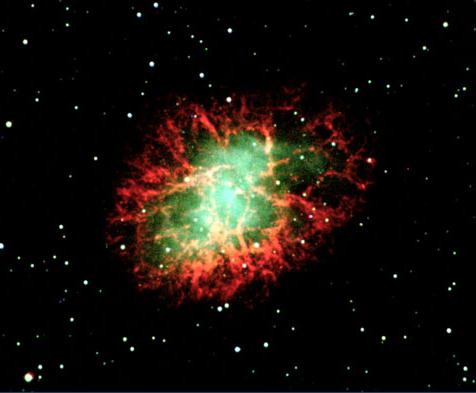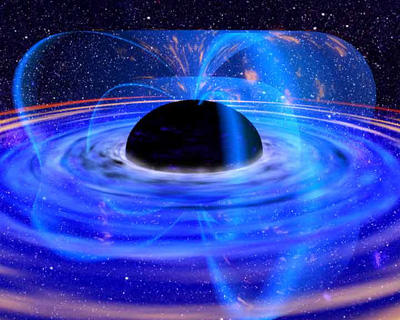The Death of Star
Gravity finally takes its toll
Remnants of a supernova |
As soon as nuclear fusion starts a balance is established between the inward crushing force of gravity and the massive nuclear explosions that are occurring in the stars core. Eventually all of the hydrogen in the core will be converted to helium. When this occurs the star will go through the red giant stage. As soon as nuclear fusion shuts off in the core, gravity, which has been trying to crush it all along, now has no adversary and it crushes the core. This causes massive compressional heating in the core that spreads to the outer parts of the star. As they become heated they over-expand which in turn causes cooling. At this point depending on the stars mass a couple things can happen, if the star is massive enough it will gravitationally collapse further and cause heating to the point where it can fuse helium to form carbon, and possibly carbon to silicon and right on down the periodic table to iron. But eventually all the fuel will be used up and the star will die in one of three death states. The three possible deaths states for a star depends solely on the mass of the original star. The white dwarf is the most common death state. It occurs to all stars that are five times the mass of our sun or less. After the red giant stage the outer layers of the star waft away and the core of the star is all that is left. The core is usually around the size of the earth and glows white, hence the name. Electron pressure keeps the core from collapsing further. Ninety-nine percent of stars will die in this manner (Star Death, 2004). However, there are rare cases of stars with masses greater than five times the mass of our sun and they have a much more spectacular death. In these cases the gravity is overwhelmingly strong and it can overcome the electron pressure forcing electron capture to occur until the core is composed of nothing but neutrons. This process takes a core that was once the size of the earth and compresses it to the size of a city. |
All of the matter in the outer layers of the star come crashing into the center at up to twenty-five percent of the speed of light. This inward crashing of mass causes the outer layers of the star to be heated to tens of billions of degrees. This causes the immediate fusion of all known elements and the resulting energy output is a supernova. Following is an enormous shockwave that blast three quarters of the stars mass into space ( Tyler, 2003). But the story is not over yet. If the mass of the original star was between five and twelve times the mass of our sun then electron capture occurs and what is left after the supernova is a ball of neutrons between one and a quarter and three times the mass of the sun, fittingly called a neutron star. It is incredibly dense material, one teaspoon weighing about the same as a large mountain (Miller, 2004). So what happens to stars over twelve times the mass of the sun? If the star is originally more than twelve times larger than the sun, the remaining core of neutrons is more than three times the mass of the sun. In this case gravity is overwhelmingly strong and is able to crush the neutron star towards zero mass. The result is a black hole with a gravitational field strong enough to not even let light escape (Brusca, 2004). |
Source: imagine.gsfc.nasa.gov/.../ news/24oct01.html Depiction of a black hole |
 source:
source: 